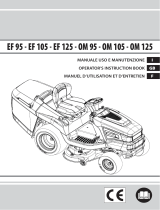
GB
17
d) Remove each adjusting key or tool before operating the
power tool. A key or tool that remains in contact with a
rotating part can cause personal injury.
e) Do not lose your balance. Always maintain adequate
support and balance. This allows better control of the power
tool in unexpected situations.
f) Dress properly. Do not wear loose clothing or jewelery. Keep
your hair, clothing and gloves away from moving parts.
Loose clothes, jewelery or long hair can be caught in moving
parts.
g) If devices are provided for the connection of dust extraction
and collection systems, ensure these are connected and
properly used. The use of these devices can reduce dust-
related hazards.
h) Do not let the familiarity gained with the frequent use of
the tools allow you to become careless and ignore the
safety principles of the tools. An act of negligence can
cause serious injury in a fraction of a second.
i) If you wish to give or lend the machine to others, make sure
that the user sees the instructions for use contained in this
manual.
4) Power tool use and care
a) Do not overload the power tool. Use the power tool suited
to the job. The appropriate power tool will perform better
and more safely at the speed at which it was designed to
operate.
b) Do not use the power tool if the switch cannot start it or
stop it normally. A power tool that cannot be controlled with
the switch is dangerous and must be repaired.
c) Remove the rechargeable battery from its housing before
making any adjustments or changing accessories, or before
storing the power tool. These preventive safety measures
reduce the risk of accidentally starting up the power tool.
d) Store unused power tools out of reach of children and do
not allow the power tool to be used by people unfamiliar
with the tool and with these instructions. Power tools are
dangerous in the hands of unskilled users.
e) Take care of power tool maintenance. Check that moving
parts are aligned and can move freely, that no parts are
broken, and for any other condition that may affect the
operation of the power tool. In the event of damage, the
power tool must be repaired before use. Many accidents are
caused by poor maintenance.
f) Keep cutting tools clean and sharp. Proper maintenance of
the cutting tools, with sharpened cutting edges, makes
them less prone to jamming and easier to control.
g) Use the power tool and its accessories according to the
instructions given, considering the work conditions and the
type of work to be performed. Using the power tool for
operations other than those for which it is intended could
result in hazardous situations.
h) Keep handles and grip surfaces dry, clean, and free from
oil and grease. Slippery handles and grip surfaces do not
enable safe handling and control of the machine in
unforeseen situations.
5) Service
Have your power tool serviced by a qualified repair person
using only original spare parts. This will ensure the safety of the
power tool.
3. RULES FOR OPERATION
How to operate the battery-powered trimmer
During operation, keep a firm and stable position, and maintain
a cautious attitude.
- Avoid working on wet or slippery ground, or on rough or
steep ground that will not ensure the operator’s stability
during operation.
- Never run, but walk and pay attention to the unevenness
of the ground and the presence of any obstacles.
- Evaluate the potential risks that may arise in the area to be
worked on, and take all the necessary precautions to
ensure your safety, particularly on slopes, uneven or
slippery land and loose ground.
- On slopes, work across the slope, never downwards or
upwards.
- Pay close attention to cliffs, ditches or embankments.
- When using the machine near the road, pay attention to
traffic.
- Pay attention when near live electrical cables.
The machine must not be used by persons who are unable to
hold it firmly with both hands and/or remain steadily balanced
on their legs while working.
The machine must not be used by more than one person.
Never use the machine if the user is tired or unwell, or has
taken medications, drugs, alcohol or substances harmful to
their ability to react and their alertness.
Techniques for using the battery-powered trimmer
Always follow the safety instructions and use cutting
techniques suitable for the type of work to be performed,
according to the instructions and examples given in the
instructions for use.
Safely handling the battery-powered trimmer
Every time it is necessary to move or transport the machine, it
is necessary to:
- switch off the motor, wait for the cutting tool to stop and
remove the battery from its housing;
- grasp the machine only by the handles and orient the
cutting device in the direction opposite the direction of
travel.
When transporting the machine with a vehicle, it must be
positioned in such a way so as not to constitute a hazard for
anyone and be firmly secured.
Recommendations for beginners
Before dealing with a mowing job for the first time, it is a good
idea to gain the necessary familiarity with the machine and the
most suitable cutting techniques, by trying to firmly grip the
machine and performing the movements required by the work.
ADDITIONAL SAFETY REGULATIONS
1) Carefully read the instructions.
2) Become familiar with the controls and the correct use of
the machine.
3) Be careful not to touch hazardous moving parts before the
machine is switched off and the hazardous moving parts
have stopped completely.
4) Wear protective goggles.
5) Never allow the machine to be used by children, or
persons unfamiliar with these instructions.











